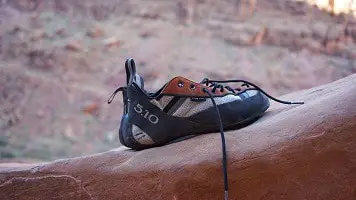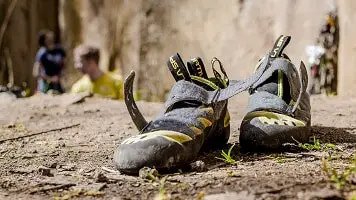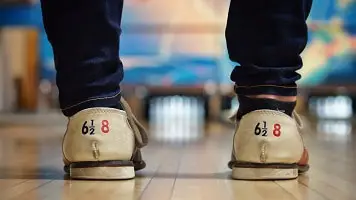Disclosure: Links marked with * are Affiliate Links. As an Amazon Associate, I earn from qualifying purchases if you decide to make a purchase through these links – at no cost for you!
Some people like to go shoe shopping. No matter if half-shoes, sports shoes or slippers, they will always find a pair that they not only like – but even fit!
Probably these people have no problems finding the right climbing shoe either. But what if you are one of those people who have wide feet?
Is there a suitable climbing shoe for you at all? – If you ask me, you will get a clear “Yes!”
Why this is so and how you can find the perfect climbing shoe for you despite wide feet, you will learn in this article. You will also get useful background information that can help you decide for – or against – a shoe.
The best climbing shoes for wide feet are La Sportiva Miura VS (Men* & Women*) and Evolv Elektra (Women*).
Why these shoes are so well suited for wide feet, you will find out in this article.
Does the Perfect Climbing Shoe for Wide Feet Even Exist?
When searching for the perfect climbing shoe, the question often arises whether there are special models for wide feet.
Although there is not one climbing shoe, the selection of climbing shoes is growing overall. This makes it easier for people with wide feet to find a well-fitting shoe for climbing/bouldering.
Before we take a closer look at shoes, let us turn our attention to feet – because feet are not all feet; and wide is not all feet.
Foot Shape
Our feet usually get little attention because we understand them all day long in shoes. This often makes us forget that each person’s feet are as individual as their hands.
If you know that you have comparatively wide feet, it is worth finding out what type of foot you have. To do this, it can be helpful to draw your foot once on a piece of paper to be able to analyze the outline more precisely. Once you have done this, it will be easier to find a well-fitting climbing shoe for your feet – and who knows, maybe this knowledge will even help you with your next pair of street shoes!
What foot shapes are there?
In principle, four types of feet are distinguished: Roman, Germanic, Celtic and Baltic.
If you often have problems with shoes that are too narrow when buying shoes, chances are that your feet are of the Baltic or Roman type.
The Roman foot type is quite broad and voluminous. The inner edges of the foot are hardly arched. If your feet have this shape, asymmetrical climbing shoes are probably rather unsuitable.
Also with the Baltic foot type, it is noticeable that the foot inner edges are hardly arched. Furthermore, the heel is very wide, so that the difference between the heel and the front part of the foot is minimal.
The key to finding the perfect climbing shoe for wide feet is to take a look at the shape of the last of the shoe (the sides).
Differences in the shape of the toes – Egyptian, Roman, Greek
A look at the toe shape can also be interesting in this context, although this information may bring fewer aha-moments for people with wide feet than the foot shape itself. For the sake of completeness here is a short summary:
With the Egyptian toe-form, the big toe is the biggest, and the size of the toes decreases evenly to the outside of the foot.
The Roman type is characterized by the fact that the two toes next to the big toe and the big toe are of equal length.
With the Greek toe, the toe directly beside the big toe is the longest toe of the foot.
With this background knowledge, we can now devote ourselves to the ideal climbing shoe for wide feet.
What Makes the Perfect Climbing Shoe?
Especially if you’ve rented your shoes in your climbing/bouldering gym so far, you might wonder what makes a well-fitting climbing shoe in general.
The shoe should fit snugly on the foot, but should not pinch uncomfortably – and under no circumstances should your toes be numb or blue after a climbing session.
Otherwise, there are many variables where you have to decide what suits you best – among others the material, the fit, velcro or laces, etc.

Related Post:
How are Rock Climbing Shoes supposed to Fit?
Which material is best suited for climbing shoes for wide feet?
Most climbing shoes are made of plastic or leather.
For wide feet, leather shoes are more suitable. Although they are initially quite tight, the material expands over time and thus adapts to the foot better than shoes made of plastic. Furthermore, they are often more odorless.
However, exceptions confirm the rule and in the end the only thing that helps is: try, try, try.

Related Post:
How to Stretch Out Climbing Shoes 👉 Step-by-Step Guide
Slippers, Velcro or shoelaces – Which closure is best suited?
As with street shoes, there are also differences in the way climbing shoes are fastened.
Slippers have to be very close to the foot to avoid slipping off the foot when using hooks. Therefore, they sit very tight at the beginning and are generally only recommended for advanced climbers. With the right fit, they could also be suitable for wide feet, but you have to try them out.
Velcro fasteners have the advantage that the shoes can be taken off and on quickly. This is very comfortable, especially in bouldering. The disadvantage, however, is that the shoes cannot be fitted so precisely to the shape of the foot and poorly made Velcro fasteners are a potential weak point.
Climbing shoes with laces have the great advantage that they can be ideally adapted to your own foot due to the lacing. The only disadvantage: it takes longer to put on and take off than with Velcro fasteners. In climbing this is no problem, in bouldering, this can be quite annoying.
Are climbing shoes with pretension, downturn or asymmetry suitable for wide feet?
Almost more important than the closure are the pre-tension, downturn and asymmetry of the shoes. They determine the basic shape of the shoe and thus determine how kicks can best be taken.
Shoes with asymmetry can be recognized by the fact that the shape differs from normal street shoes. The lasts are designed in such a way that you will find ideal support when taking small steps. However, shoes with strong asymmetry are rather unsuitable for the foot types Baltic and Roman, as well as the toe shapes Roman and Greek since these foot types are subject to stronger constraints than a foot of the type “Germanic” or “Celtic” due to their characteristics in a strongly asymmetrical shoe. Whether you can use climbing shoes with weak asymmetry, on the other hand, is something you should try out.
In a shoe with a downturn, only the front part of the shoe is affected. The aim is to provide more power in the forefoot by placing the toes more upright and thus achieve better performance in the overhang.
A climbing shoe with pretension is characterized by the fact that the heel of the shoe is pulled forward. This means that more pressure can be applied to the tip of the foot, making it easier to take narrow steps.
Both pre-tensioning and downturn can be used well even with wide feet – however, if you are a beginner (i.e. you go climbing once or twice a week for less than twelve months), it is advisable to use shoes without pre-tensioning and downturn to give your feet the opportunity to build up the necessary muscles first. Furthermore, even specially shaped climbing shoes are of little use if the technique is not right.
Attention! Even if pretension, downturn and asymmetry are supposed to support the foot, these climbing shoe characteristics are not a prerequisite for good climbing results. It is much more important that the shoe fits you well and that you are free of pain even after a longer climbing or bouldering session.
Where Can You Get Climbing Shoes for Wide Feet?
When buying climbing or bouldering shoes, you have the choice between a well-equipped sports store and online retail.
Advantages and Disadvantages of Online vs. Real Store
Sports Store
Pros:
- Consulting
- Can be tried on immediately
- For defects: simple complaint
Cons:
- often a very limited selection
Online Store
Pros:
- large selection
- simple return procedures (stores are set up for try-on orders)
- partial experience reports as evaluations
Cons:
- no personal consultation
In the end, it depends on your personal preference where you want to buy your climbing shoes.
Another option is to first visit the sports stores in your area, try on the models there – and analyze why a particular shoe doesn’t fit you. This can be very helpful when ordering!
A tip for women with wide feet
For women with wide feet – or the foot shape Baltic or Roman – it may be helpful to browse through the models for men or both sexes. The shoes there are often cut a little wider, which can make it easier to find well-fitting climbing or bouldering shoes.
General tip for buying climbing shoes
It is best to check for climbing shoes at about the same time you would normally go climbing/bouldering, as your feet often grow up to half a shoe size during the course of the day.
And even if it takes you a while to find the right shoe for your feet: it’s worth investing the necessary time and not being satisfied with a compromise. Somewhere out there is the right shoe for you!

Related Post:
In Which Size Should I Buy Climbing Shoes? 👉 Guide
Best Climbing Shoes For Wide Feet
A look at online retailing shows that there are vast numbers of different shoe models of different brands. To make the choice a little easier for you, here are some recommendations. Maybe there is already the right shoe for you!
La Sportiva – Miura VS
The La Sportiva brand is generally highly regarded among climbing enthusiasts. This is partly due to the high quality and partly to the wide range of different models.
It is therefore not surprising that La Sportiva also has a model in its range that is designed for wide feet: the Miura VS. This shoe is available for women* and men* and can be adjusted to the individual needs of your foot with three velcro fasteners.
The Miura VS is ideal for you if you already have some experience in climbing/boarding.
Pros:
- good workmanship
- 3 velcro fasteners for an ideal fit
- available for women and men
- Material: Leather
Cons:
- slight asymmetry
Evolv Electra
The Evolv Elektra* is ideal if you’re looking for a shoe without pre-tension and a downturn. The leather used widens slightly over time, so the shoe fits well even with wide feet.
The only drawback is that the Evolv Elektra is slightly asymmetrical.
Pros:
- good workmanship
- neither pretension nor downturn
- Leather expands with time
Cons:
- slight asymmetry
Other Shoes, Which Are Recommended For Wide Feet
Related questions
Socks – yes or no?
If you have just started climbing, you may wonder if socks are worn in climbing and bouldering shoes.
In principle applies here: To everyone in the way he/she likes it better. You should note, however, that when you buy your shoes, you should already make sure that they fit you well in your preferred version.
It is also possible to use test socks. These are much thinner than normal socks, but at the same time the foot does not come into direct contact with the material of the shoe. There are climbing enthusiasts who describe this as pleasant.
One advantage of wearing socks is that with a little luck the shoe will start later to smell of sweaty feet. However, in the long run, this is probably almost impossible to avoid.
Can you avoid the smell of your climbing shoes?
The simple answer is: in the long run, unfortunately, no. But there are ways to delay the formation of odors:
- Let it dry! This means that the odor-forming bacteria are missing an important component for survival and reproduction.
- Between individual routes. This causes your feet to cool down faster after a route and prevents the sweat from settling into the material of the shoes.
- Prefer leather as a material. It has been proven that shoes made of genuine leather are more resistant to odor than those made of artificial leather or other synthetic materials.

Related Post:
How to Clean Climbing Shoes: Wash and Care Instructions
How can I dry my climbing shoe faster?
To dry a shoe in the shortest possible time, you can use simple newspaper or kitchen paper. This quickly absorbs the moisture and thus removes an important basis of life for the odor-forming bacteria.
Under no circumstances should the climbing shoes be blow-dried or placed on a heater. The direct heat makes the material brittle more quickly, making it more susceptible to damage when bouldering.
For light-colored bouldering/climbing shoes, unprinted kitchen paper is preferable. Newsprint has a chance of rubbing off the ink.
What to do if the climbing shoes start to smell unpleasant despite all caution?
If, despite all precautions, your shoes start to smell bad, you can wash them out with neutral soap and brush under lukewarm water. Then let them dry well!
Treatment with sodium bicarbonate can also be helpful. Due to its basic pH value, it neutralizes the acid present in the sweat and thus causes the bacteria to no longer find a good environment.
Can I throw my shoes in the washing machine?
No matter how much the shoes stink – we strongly advise against washing them in the washing machine! Both the detergent and the temperatures can be poisonous to the rubber being processed; there is also a high probability that the nubs in the machine will additionally attack the rubber.
Conclusion
There is the right climbing shoe for your feet – no matter how wide they are. All you need is a little patience and the courage to try different models.
With this in mind: Good luck on your journey to the perfect climbing shoe!
Attention: You have to take care of your safety when climbing! The information on climbtheearth.com only helps you to learn. Before you climb, you should make sure that you have been properly instructed by an expert and that you follow all safety precautions.
Disclosure: This website is the property of Martin Lütkemeyer and is operated by Martin Lütkemeyer. Martin Lütkemeyer is a member of the Amazon Services LLC Affiliate Program, an affiliate advertising program designed to enable Web sites to earn advertising revenue through advertising and linking to Amazon.com. Links marked with * are affiliate links.




